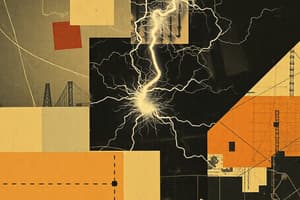Podcast
Questions and Answers
What is the electric current intensity passing through the conductor if the quantity of charges flowing is represented as 2 Ampere?
What is the electric current intensity passing through the conductor if the quantity of charges flowing is represented as 2 Ampere?
- 1 Ampere
- 2 Ampere (correct)
- 0.5 Ampere
- 1.5 Ampere
How many electrons are flowing through the conductor in 8 seconds if an electric current of 3 A is passing through?
How many electrons are flowing through the conductor in 8 seconds if an electric current of 3 A is passing through?
- 1.5 × 10^21 electrons
- 1.5 × 10^18 electrons
- 1.5 × 10^20 electrons (correct)
- 1.5 × 10^19 electrons
What is the resistance of a conductor if it requires 120 volts to move a stream of 6.5×10^18 electrons in 2 seconds?
What is the resistance of a conductor if it requires 120 volts to move a stream of 6.5×10^18 electrons in 2 seconds?
- 121 Ohms
- 38.4 Ohms
- 230 Ohms
- 57.7 Ohms (correct)
If a conductor with a resistance of 20Ω carries a current of 2 Amperes, what happens to its resistance when it carries 1 Ampere?
If a conductor with a resistance of 20Ω carries a current of 2 Amperes, what happens to its resistance when it carries 1 Ampere?
What is the highest resistance among the options given, based on the graphical representation provided?
What is the highest resistance among the options given, based on the graphical representation provided?
What is the ratio of the electric resistance of conductor A to conductor B if it is expressed as 𝒓𝒂𝒕𝒊𝒐 =…?
What is the ratio of the electric resistance of conductor A to conductor B if it is expressed as 𝒓𝒂𝒕𝒊𝒐 =…?
What is the conductivity of a wire which is 30 meters long, with a cross-sectional area of 0.3 cm² and a potential difference of 0.8 V with current intensity of 2 A?
What is the conductivity of a wire which is 30 meters long, with a cross-sectional area of 0.3 cm² and a potential difference of 0.8 V with current intensity of 2 A?
What is the resistance per unit length for a wire connected to a factory, given a total distance of 2.5 km and current of 80 A with voltage drop from 240 V to 220 V?
What is the resistance per unit length for a wire connected to a factory, given a total distance of 2.5 km and current of 80 A with voltage drop from 240 V to 220 V?
What is the specific resistivity of mercury based on the given thread specifications?
What is the specific resistivity of mercury based on the given thread specifications?
If the resistivity of a conductor is 0.5 Ω.m, what is the product of resistivity and conductivity?
If the resistivity of a conductor is 0.5 Ω.m, what is the product of resistivity and conductivity?
What happens to the resistance of a wire when its length is doubled and its radius is halved?
What happens to the resistance of a wire when its length is doubled and its radius is halved?
What is the resistance of a conductor of length 5 m and cross-sectional area three times larger than a 20 m conductor with resistance 108 Ω?
What is the resistance of a conductor of length 5 m and cross-sectional area three times larger than a 20 m conductor with resistance 108 Ω?
If the length of a resistance wire is doubled and its sectional area is halved, how does its resistance change?
If the length of a resistance wire is doubled and its sectional area is halved, how does its resistance change?
For two copper wires of the same length, if the second wire's cross-sectional area is three times larger, what is the ratio of their resistances?
For two copper wires of the same length, if the second wire's cross-sectional area is three times larger, what is the ratio of their resistances?
In a scenario with four uniform conductors of the same material, how should they be arranged according to their electrical resistance from least to greatest?
In a scenario with four uniform conductors of the same material, how should they be arranged according to their electrical resistance from least to greatest?
What change in dimensions of the second conductor allows a current of 3I to flow if the first conductor with current I has a length L and cross section area 3A?
What change in dimensions of the second conductor allows a current of 3I to flow if the first conductor with current I has a length L and cross section area 3A?
If the diameter of the first wire is three times that of the second wire and the resistance of the second wire is four times that of the first, what is the ratio of the length of the second wire to the length of the first wire?
If the diameter of the first wire is three times that of the second wire and the resistance of the second wire is four times that of the first, what is the ratio of the length of the second wire to the length of the first wire?
What is the average electromotive force (e.m.f) between a cloud and the ground if the average current is 1.5×10^4 A, energy released is 3×10^8 J, and the duration of the lightning strike is 2×10^-4 S?
What is the average electromotive force (e.m.f) between a cloud and the ground if the average current is 1.5×10^4 A, energy released is 3×10^8 J, and the duration of the lightning strike is 2×10^-4 S?
Given the relationship between length and area in the provided scenario, what is the likely effect of reducing the cross-sectional area on the current through a conductor?
Given the relationship between length and area in the provided scenario, what is the likely effect of reducing the cross-sectional area on the current through a conductor?
If the resistance of a conductor increases, what happens to the current flowing through it for a constant voltage?
If the resistance of a conductor increases, what happens to the current flowing through it for a constant voltage?
In an electrical circuit, if the same material is used for conductors of different lengths, how does the length impact the resistance?
In an electrical circuit, if the same material is used for conductors of different lengths, how does the length impact the resistance?
Flashcards are hidden until you start studying
Study Notes
Electric Current and Resistance Concepts
- Current intensity is measured in Amperes (A), indicating the flow of electric charge in a conductor.
- The quantity of electrons flows through the conductor, calculated based on current and time, with the fundamental charge of an electron being approximately 1.6 x 10^-19 C.
- Resistance (R) can be determined from voltage (V) and current (I) using Ohm's Law: R = V/I.
- Resistance varies based on the conductor's dimensions and material properties, reflected in the formula: R = ρ(L/A), where ρ is resistivity, L is length, and A is the cross-sectional area.
Key Calculations and Examples
- Increasing the length of a wire while decreasing its diameter significantly increases resistance; doubling the length and halving the diameter yields resistance that is eight times larger.
- For wires with different cross-sectional areas but identical lengths, the greater the cross-sectional area, the lower the resistance.
Specific Scenarios
- Connecting two wires to a power source can experience voltage drops, important in calculating efficiency and power losses across long distances.
- Conductivity (σ), the inverse of resistivity, indicates how easily a material allows electric flow, expressed as σ = 1/ρ.
Power and Energy Considerations
- Power is calculated using the formula P = IV, where I is current and V is voltage.
- The relationship between energy, voltage, and charge can be represented as E = QV, facilitating understanding of power delivery in electrical systems.
Applications to Real-World Situations
- Understanding the resistance of materials like mercury aids in selecting appropriate conductors for particular applications based on current requirements and environmental factors.
- Lightning strikes exemplify rapid current flow, capable of producing significant e.m.f (electromotive force), vital for calculating electric impact and safety measures in electrical engineering.
Comparative Resistance Analysis
- In systems with multiple conductors of varying dimensions, the electrical resistance can be ranked based on their geometrical properties and material uniformity.
- Ratios of resistance between wires illustrate direct relationships to differences in cross-sectional area and lengths, essential in engineering for designing effective circuits.
Studying That Suits You
Use AI to generate personalized quizzes and flashcards to suit your learning preferences.




